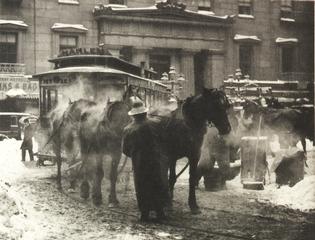| 4 of 10 |

| What Makes This Photo Pictorial? | |
|
Critic Robert Hughes on Stieglitz: “ His career spanned two cultural worlds in America: in it all manner of strands, both nineteenth- and twentieth-century, twined together, producing a uniquely vigorous . . . temperament. He was courageous, obdurately persistent, impatient with fools, and sometimes an arrogant prig. He could change his opinions but was incapable of compromise. A twentieth-century American, but with the bark still on him.” (American Visions, 1997) |
“As Stieglitz tells it… he had returned from Europe in 1890 and found New York to be a culturally barren place, and wondered how he was ever going to live in this desolation. He was out tromping around New York photographing, and came upon the streetcar driver patiently watering his horses at the end of the line. When he saw the streetcar driver nourishing his horses so they could continue their journey, Stieglitz decided that he should assume the same role and nourish the arts in this country.” (Sarah Greenough, In Focus: Alfred Stieglitz, 1995)
When Stieglitz took this picture in 1892 he was interested in pictorial photography, a style of picture-making that was meant to put photography on the same level as other art forms, such as painting and sculpture. For Pictorialist photographers, the everyday scenes in front of their cameras were not by themselves subjects for great art; the photographers needed to shape the picture to express their own artistry. Photographers used many devices to shape a photograph, and there were a few elements that applied to most turn-of-the-century pictorial photographs, including this one. Click on the diagram bar above to find out what makes this photo Pictorial.
| 4 of 10 |
